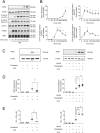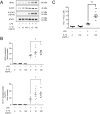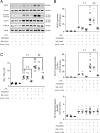MEK inhibitors increase the mortality rate in mice with LPS-induced inflammation through IL-12-NO signaling
- PMID: 37833247
- PMCID: PMC10575927
- DOI: 10.1038/s41420-023-01674-w
MEK inhibitors increase the mortality rate in mice with LPS-induced inflammation through IL-12-NO signaling
Abstract
Lipopolysaccharide (LPS) is an endotoxin that can cause an acute inflammatory response. Nitric oxide (NO) is one of the most important innate immune system components and is synthesized by inducible NOS (iNOS) in macrophages in response to stimulation with LPS. LPS activates the RAS-RAF-mitogen-activated protein kinase/ERK kinase (MEK)-extracellular-signal-regulated kinase (ERK) signaling cascade in macrophages. The purpose of this study was to examine how the combination of LPS and MEK inhibitors, which have been used as anticancer agents in recent years, affects inflammation. We showed that MEK inhibitors enhanced iNOS expression and NO production in LPS-stimulated mouse bone marrow-derived macrophages. A MEK inhibitor increased the mortality rate in mice with LPS-induced inflammation. The expression of the cytokine interleukin-12 (IL-12) in macrophages was enhanced by the MEK inhibitor, as shown by a cytokine array and ELISA. IL-12 enhanced iNOS expression and NO production in response to LPS. We also showed that tumor necrosis factor (TNF-α) was secreted by macrophage after stimulation with LPS and that TNF-α and IL-12 synergistically induced iNOS expression and NO production. An anti-IL-12 neutralizing antibody prevented NO production and mortality in an LPS-induced inflammation mouse model in the presence of a MEK inhibitor. These results suggest that the MEK inhibitor increases the mortality rate in mice with LPS-induced inflammation through IL-12-NO signaling.
© 2023. Cell Death Differentiation Association (ADMC).
Conflict of interest statement
The authors declare no competing interests.
Figures








Similar articles
-
Contribution of iNOS/sGC/PKG pathway, COX-2, CYP4A1, and gp91(phox) to the protective effect of 5,14-HEDGE, a 20-HETE mimetic, against vasodilation, hypotension, tachycardia, and inflammation in a rat model of septic shock.Nitric Oxide. 2013 Sep 1;33:18-41. doi: 10.1016/j.niox.2013.05.001. Epub 2013 May 14. Nitric Oxide. 2013. PMID: 23684565 Free PMC article.
-
Trametinib, a novel MEK kinase inhibitor, suppresses lipopolysaccharide-induced tumor necrosis factor (TNF)-α production and endotoxin shock.Biochem Biophys Res Commun. 2015 Mar 13;458(3):667-673. doi: 10.1016/j.bbrc.2015.01.160. Epub 2015 Feb 13. Biochem Biophys Res Commun. 2015. PMID: 25684183
-
Amelioration of TPA-induced skin inflammation by the leaf extract of Vernonia amygdalina involves ERK/STAT3 (Ser727) signaling inhibition.Phytomedicine. 2022 Jul 20;102:154194. doi: 10.1016/j.phymed.2022.154194. Epub 2022 May 23. Phytomedicine. 2022. PMID: 35660348
-
Inhibition of p38 and ERK MAP kinases blocks endotoxin-induced nitric oxide production and differentially modulates cytokine expression.Pharmacol Res. 2004 May;49(5):433-9. doi: 10.1016/j.phrs.2003.11.004. Pharmacol Res. 2004. PMID: 14998552
-
Modulation of lipopolysaccharide-induced neuronal response by activation of the enteric nervous system.J Neuroinflammation. 2014 Dec 12;11:202. doi: 10.1186/s12974-014-0202-7. J Neuroinflammation. 2014. PMID: 25497784 Free PMC article.
Cited by
-
The Galloyl Group Enhances the Inhibitory Activity of Catechins against LPS-Triggered Inflammation in RAW264.7 Cells.Foods. 2024 Aug 21;13(16):2616. doi: 10.3390/foods13162616. Foods. 2024. PMID: 39200543 Free PMC article.
-
Nanodrug Delivery Systems for Direct Clearance or Neutralization of LPS.Int J Nanomedicine. 2025 Jul 3;20:8653-8673. doi: 10.2147/IJN.S510037. eCollection 2025. Int J Nanomedicine. 2025. PMID: 40626135 Free PMC article. Review.
References
-
- Kennedy LB, Salama AKS. A review of cancer immunotherapy toxicity. CA Cancer J Clin. 2020;70:86–104. - PubMed
Grants and funding
LinkOut - more resources
Full Text Sources
Research Materials
Miscellaneous

